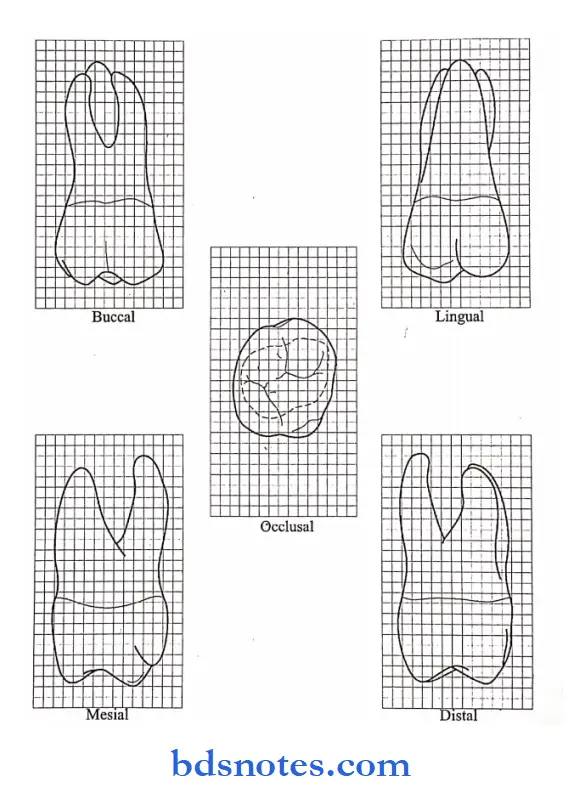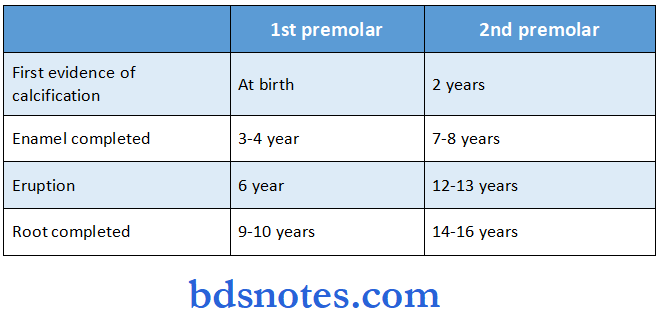The Permanent Maxillary Molars
Question 1. Describe in detail the morphology of the maxillary permanent 1st molar. Add a note on its chronology. (or) Occlusal surface of permanent maxillary 1st molar.
Answer:
- They are two in number.
- They are the largest and strongest teeth.
- They assist the mandibular molars in performing mastication.
- It has four well-developed functioning cusp and one supplemental cusp called caplet.
Read And Learn More: BDS Previous Examination Question And Answers
Buccal aspect:
- The crown is roughly trapezoidal.
- The cervical line is the shorter of the uneven sides.
- The buccal surface is convex.
- Parts of mesiobuccal, distobuccal, mesiolingual, and distolingual cusps.
- The mesial slope of the mesiobuccal cusp meets its distal slope at an obtuse angle.
- The mesial slope of the distobuccal cusp meets its distal slope at approximately a right angle.
- The buccal developmental groove divides the two buccal cusps.
- At the end of it, a buccal pit is present.
- The mesial outline is straight while the distal outline is convex.
- The cervical line is almost straight.
- All three of the roots may be seen with their apexes inclined distally.
- The mesiobuccal root curves distally, while the distal root is straighter.
- A deep developmental groove is seen on root trunks, the lingual root is the longest and the two buccal roots are equal in length.
- The roots are about twice as long as the crown.
Lingual aspect:
- The surface is convex.
- It presents two lingual cusps and a caplet “the cusp of clarabella”.
- The mesiolingual cusp is the largest.
- The angle formed by the mesial outline of the crown and the mesial slope of the mesiolingual cusp is almost 90 degrees.
- The angle formed by the mesial and distal slopes of the mesiolingual cusp is obtuse.
- The fifth cusp is seen on the mesiolingual surface of the mesiolingual cusp.
- The distolingual cusp is smooth and spheroidal.
- All three roots are visible with the lingual root being the largest.
- A lingual developmental groove separates the two major lingual cusps.
- The cervical line is almost straight.
Mesial aspect:
- The surface is almost flat.
- The lingual outline curves outward and lingually.
- The mesial marginal ridge is irregular.
- The cervical line is concave apically.
- The mesiobuccal root hides the distobuccal root.
- The mesial contact area is apical to the marginal ridge.
- The mesiobuccal root is broad and flat and ends at the blunt apex.
- The level of the bifurcation is closer to the cervical line.
- The lingual root is longer and banana-shaped, and the ends are rounded apex.
- The root appears more pointed toward the end than the mesiobuccal root.
Distal aspect:
- The surface is convex.
- Most of the buccal surface may be seen.
- The distal marginal ridge dips sharply cervically.
- The cervical line is almost straight.
- The distobuccal root is narrower.
- The level of the bifurcation is 5 mm from the cervical line.
Occlusal aspect:
- The surface is rhomboid.
- The proximal surfaces are convex buccally.
- It presents 4 cusps – mesiolingual, mesiobuccal, distóbuccal, and distolingual and a fifth cusp, the cusp of carabelli on the largest mesiolingual cusp.
- The angles formed by mesiobuccal and distolingual cusps are acute while mesiolingual and distobuccal cusps are obtuse,
- The maxillary molar primary cusp is triangular and is formed by mesiolingual and two buccal cusps.
- The mesial marginal ridge and the oblique ridge.
Fossae:
1. Major fossae:
- Central fossa:
- It is roughly triangular.
- It is located mesial to the oblique ridge.
- It is bound by the distal slope of the mesiobuccal cusp, the mesial slope of the distobuccal cusp, the crest of the oblique ridge, and the crest of the two triangular ridges of the mesiobuccal and mesiolingual cusps.
- It contains supplemental grooves, short grooves, and a central developmental pit.
Distal fossa:
- It is roughly linear.
- It is present distal to the oblique ridge.
2. Minor fossae:
Mesial triangular fossa:
- It is distal to the mesial marginal ridge.
- It is triangular in shape with its base at the mesial marginal ridge and its apex at the point where the supplemental grooves join the central grooves.
Distal triangular fossa:
- It is mesial to the distal marginal ridge.

Ridges:
1. Oblique ridge.
- It crosses the occlusal surface obliquely
- It is formed by the union of the triangular ridge of the distobuccal cusp and the distal ridge of the mesiolingual cusp.
2. Mesial and distal marginal ridges – irregular.
Grooves:
1. Buccal developmental groove.
- Radiates buccally at the bottom of the buccal sulcus of the central fossa.
2. Central developmental groove.
- It terminates at the apex of the mesial triangular fossa.
3. Transverse groove of the oblique ridge.
- It is a shallow groove joining the oblique ridge with the central and distal fossae.
4. Distal oblique groove.
- It transverses the deepest portion of the distal fossa.
5. Lingual developmental groove.
- It is connected with the distal oblique groove at the junction of the cusp ridges of the mesiolingual and distolingual cusps.
6. Fifth cusp groove.
- It outlines a fifth cusp.
Roots.
- There are three roots – mesiobuccal, distobuccal, and palatal root.
- The palatal root is the longest and the distobuccal root is the shortest.
Measurements:
- Cervico-occlusal crown length -7.5 mm
- Root length – buccal – 12 mm, lingual – 12 mm
- Mesiodistal crown diameter – 10 mm
- Mesiodistal crown diameter at cervix – 8 mm
- Buccolingual crown diameter – 11 mm
- Buccolingual crown diameter at cervix – 10 mm
- Curvature of cervical line- mesial – 1 mm
- The curvature of the cervical line – distal -0 mm.
Question 2. Describe the morphology of the maxillary permanent second molar. (or) Occlusal surface of permanent maxillary 2nd molar.
Answer:
The maxillary second molar supplements the first molar is function.
Buccal aspect:
- The distobuccal cusp is smaller.
- The buccal roots are about the same length and inclined distally.
- The end of the distobuccal root is slightly distal to the distal extremity of the crown.
- The apex of the mesiobuccal root is on a line with the buccal groove of the crown.
Lingual aspect:
- The distolingual cusp of the crown is smaller.
- No fifth cusp is present.
- The apex of the lingual root is in line with the distolingual cusp tip.
Mesial aspect:
- The roots are within the confines of the buccolingual crown outline.
Distal aspect:
- The distobuccal cusp is smaller.
- The more mesiobuccal cusp may be seen.
- The apex of the lingual root is in line with the distolingual cusp.
Occlusal aspect:
- Surface is rhomboid.
- The mesiobuccal and mesiolingual cusps are large and well developed.
- The distobuccal and distolingual cusps are smaller and not so well developed.
- Supplemented grooves and pits are seen on the occlusal surface.

Question 3. Write the difference between the permanent maxillary first molar and the permanent maxillary second molar.
Answer:

Question 4. Chronology of permanent maxillary 1st and 2nd molar.
Answer:

Question 5. Cusp of Clarabella.
Answer:
- It is a rounded projection on the surface of the crown and represents a deviation from the normal.
Location:
- On the mesiolingual surface of the mesiolingual cusp of the permanent maxillary 1st molar.
Measurements:
- Cervico-occlusal crown length -6.5 mm
- Root length – 11 mm
- Mesiodistal crown diameter -8.5 mm
- Mesiodistal crown diameter at cervix 6.5 mm
- Bucco-lingual crown diameter – 10 mm
- Bucco-lingual crown diameter at cervix -9.5 mm
- Curvature of cervical line – mesial – 1 mm
- The curvature of the cervical line – distal – 0 mm
Leave a Reply